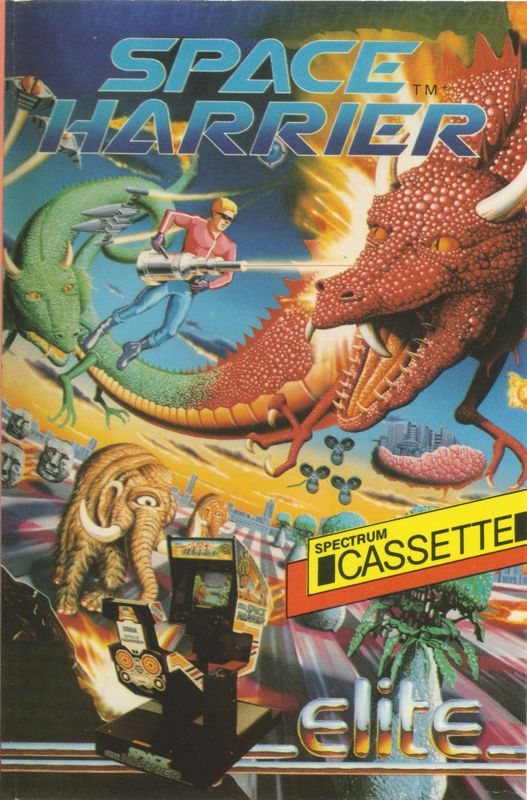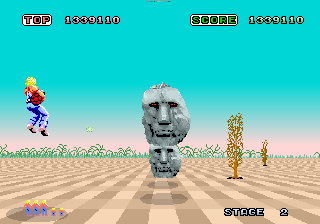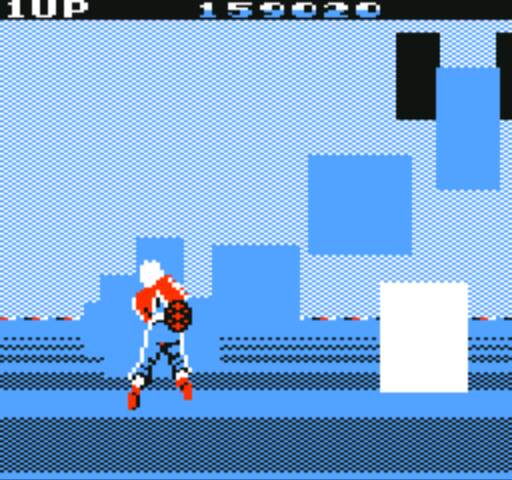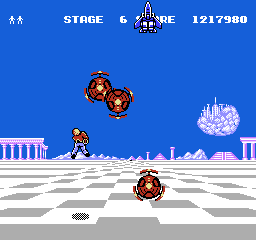Retro Replay Review
Gameplay
Space Harrier’s gameplay is immediate and exhilarating: you run, fly and dodge through a gauntlet of alien adversaries while returning fire with a massive cannon. The core loop is simple yet endlessly engaging—steer the hero around incoming waves of enemies, avoiding hazards and unleashing a steady stream of projectiles. Quick reflexes are your best asset, but spatial awareness and pattern recognition are equally crucial when bosses appear at the end of each stage.
(HEY YOU!! We hope you enjoy! We try not to run ads. So basically, this is a very expensive hobby running this site. Please consider joining us for updates, forums, and more. Network w/ us to make some cash or friends while retro gaming, and you can win some free retro games for posting. Okay, carry on 👍)
The pseudo-3D rail-shooter framework provides a strong sense of forward momentum. You don’t control the camera; instead, the environment charges toward you, demanding split-second decisions to dodge or strike. Movement speed is adjustable, letting veterans crank up the pace for a nerve-shredding challenge or dial it back to soak in the scenery and plan each maneuver. That degree of player agency over velocity adds replay value—once you’ve memorized a level at slow speed, try blasting through at maximum throttle.
Despite its arcade origins, Space Harrier rewards both casual pick-up-and-play sessions and marathon high-score grinding. Power-ups and weapon upgrades appear at strategic points, giving brief windows of firepower supremacy before the next boss encounter. Learning each boss’s attack patterns becomes a satisfying puzzle in its own right. For anyone seeking a high-octane experience that strips gaming down to its most fundamental thrills—dodge, aim, fire—this title remains a benchmark.
Graphics
Space Harrier’s visuals were groundbreaking at release, showcasing pseudo-3D scaling sprites in a period when most shooters were strictly two-dimensional. The result is a vibrant, surreal landscape that feels like a living diorama hurtling toward you. Alien creatures pop into view with dramatic scaling effects that remain impressive even by modern retro-enthusiast standards.
Color palettes across stages range from candy-colored dreamscapes to brooding alien worlds, each filled with whimsy and menace in equal measure. The smooth sprite scaling and clever use of parallax layers create an illusion of depth rarely achieved in early ’80s arcade titles. Every dune, tower and enemy formation feels sculpted to heighten the perception of speed and looming danger.
While contemporary systems can render true 3D polygons, Space Harrier’s art direction still carries a timeless charm. The exaggerated proportions of your hero’s arm-mounted cannon, the giant flying heads and the sprawling checkerboard plains all contribute to a vivid, memorable aesthetic. For modern players, the graphics offer a delightful throwback, capturing the spirit of arcade spectacle in a package that still delights the eye.
Story
Space Harrier’s narrative is succinct but serviceable: you are the lone hero in a fantastical world under siege by relentless alien hordes. There’s no deep cutscene exposition; instead, the action unfolds in real time as you blaze through lush forests, sunlit deserts and neon-drenched alien fortresses. The sense of urgency and high stakes is conveyed entirely through gameplay pace and enemy onslaughts.
The connection to the Fantasy Zone series is more aesthetic than narrative—both share a whimsical, off-the-wall design philosophy and a penchant for bright, otherworldly locales. However, Space Harrier stands apart in tone. It trades the cute, sprawling maps of Fantasy Zone for straight-ahead, hyper-concentrated combat arenas that feel like living postcards from an alien carnival.
Story purists may find the plot minimal, but the game’s charm lies in its unrelenting action rather than elaborate lore. Each stage feels like a vignette in a larger cosmic struggle, and the end-of-level bosses serve as dramatic milestones in your heroic campaign. For players who prioritize gameplay intensity over story depth, the lean narrative provides ample motivation without bogging down the momentum.
Overall Experience
Space Harrier delivers a pure adrenaline rush that few games can match, even decades after its arcade debut. The seamless blend of fast-paced rail shooting, colorful pseudo-3D visuals and responsive controls make every playthrough feel fresh. Whether you’re chasing high scores or simply reveling in the spectacle, the game’s breakneck pacing keeps you on the edge of your seat.
Replayability is high: mastering each level, adjusting movement speed or attempting no-death runs against every boss provides ample challenges for dedicated players. The absence of a convoluted story or lengthy cutscenes means you’re in and out of the action instantly—ideal for quick sessions or extended runs. The smooth difficulty curve strikes a balance between accessibility for newcomers and brutal speedruns for arcade veterans.
For anyone interested in gaming history or classic shooters, Space Harrier remains a vital experience. It embodies the essence of early arcade design: compelling mechanics, bold visuals and a “one more coin” allure that’s hard to ignore. Even in modern compilations or retro reissues, its energy and charm endure, making it a standout title for collectors, retro enthusiasts and any player seeking a high-octane, timeless thrill ride.
 Retro Replay Retro Replay gaming reviews, news, emulation, geek stuff and more!
Retro Replay Retro Replay gaming reviews, news, emulation, geek stuff and more!









Reviews
There are no reviews yet.